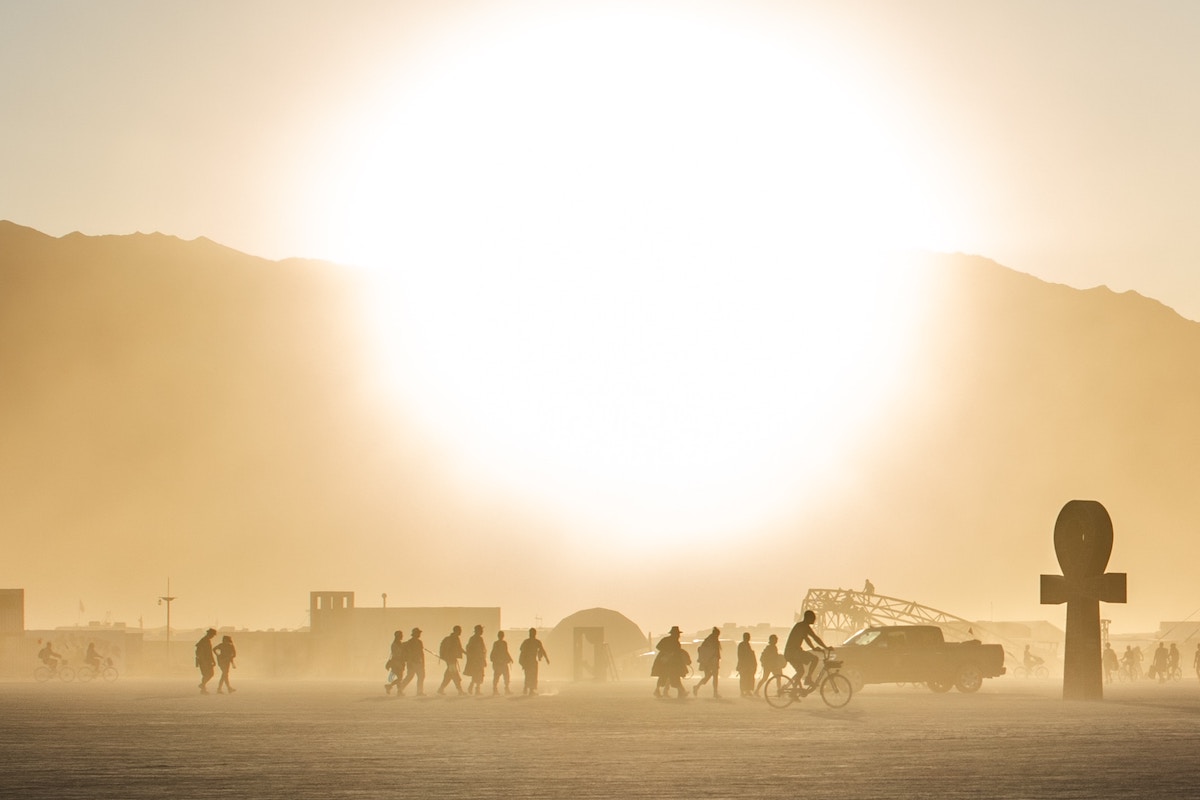Skift Take
This year's Burning Man turned into a muddy mess when severe flooding left thousands stranded. Is it time we revisit contingency plans for outdoor events?
This year’s Burning Man was mired in mud in the remote desert area dubbed Black Rock City in northwestern Nevada. This made the four-mile unpaved road to and from the festival impassable for a stretch, stranding tens of thousands. When the skies cleared, a mass exodus added to the chaos.
What Happened
Things got off to a rocky start at the beginning of the nine-day festival when climate and anti-capitalist activists blocked the two-lane road into the site, demanding the banning of private jets and single-use plastics. According to a statement from Seven Circles, a coalition of activist groups that organized the protest, the blockade aimed to spotlight “capitalism’s inability to address climate and ecological breakdown.”
This was nothing compared to what was to come next. Days before the official opening, Hurricane Hilary had drenched the area, making it hard to build the festival’s famous art installation and stages across the desert landscape. The clay surface was unable to absorb the water.
Unfortunately, there was more rain to come, caused by Hilary’s tail. On Friday night, months of rain fell in one day, and temperatures dropped. This made driving impossible and severely hampered walking.
How Organizers Responded
When the deluge started, organizers closed the main access road in and out of Black Rock City and imposed shelter-in-place orders. Only emergency vehicles were allowed to circulate. They also advised attendees to conserve food, water, and fuel.
Organizers added mobile cell trailers placed in “strategic positions” to allow internet access on Saturday evening. Buses were deployed to Gerlach — a small Nevada town attendees drive through to get to the festival — to transport people to Reno.
In a statement, Burning Man said the community was “well-prepared for a weather event like this,” having practiced drills and “engaged full-time on all aspects of safety.” Organizers were in “constant communication” with local, county, state, tribal, and federal officials, according to a statement issued by festival spokesperson Dominique Debucquoy-Dodley. “We will all get out of this. It will just take time,” the statement said.
The organizers communicated regularly with attendees via the festival website and X (Twitter). One man died at the event during the period of heavy rain, but the cause of death was not disclosed. Despite the extreme circumstances, there were no other major incidents to report. Burners, what festival attendees call themselves, did admit that the rain and mud made it hard to navigate, but most didn’t let the weather dampen their good time.
Keeping Spirits Up
At its heart, Burning Man is about fellowship. “Burning Man is a community of people who are prepared to support one another. We have come here knowing this is a place where we bring everything we need to survive. It is because of this that we are all well-prepared for a weather event like this,” its website stated.
The work of the organizers and the burner spirit made what could have been a disastrous situation more annoying than dangerous. Jason Koop, vice president, sales and marketing of the Canadian Special Events Magazine, posted a video of attendees battling with the mud on LinkedIn. He told Skift Meetings, “I spoke to a couple of friends who were driving out tonight […] and they had nothing but good things to say about the officials they encountered and the people who welcomed them into their RV during the worst of it.”
Reno-Sparks CVA Ready to Help
As the weather deteriorated, the Reno-Sparks Convention and Visitors Authority (RSCVA) joined other local agencies with contingency plans. “It was a unified community effort to provide any and all assistance according to conditions,” said Mike Larragueta, the interim president and VP of sales for the RSCVA.
The Reno-Sparks Convention Center is a 600,000-square-foot facility with five exhibit halls. The center made halls One and Two available for emergency shelter if needed. Six hundred parking spots were also available for vehicles coming off the Playa.
“The weather was our friend yesterday, and we did not have a single request for parking or shelter, although we were ready to go,” said Larragueta.
Although delayed, the eponymous Man effigy was burned with fireworks and other explosions on Monday night rather than the scheduled Sunday night.
Approximately 60,000 Burners exited the Playa on Tuesday, and Larragueta noted that most vehicles looked clean. “After Burning Man, we always see an influx of vehicles in our community, and they are usually really dirty from the dust. Not this year. The caked mud must have just broken off,” he said.
Outdoor Gatherings Filled with What-Ifs
The variables that come with the planning of any event are amplified even further when gathering outdoors. In August, heavy rains impacted the Wacken heavy metal festival in northern Germany. Organizers reduced the visitor capacity and had to turn away some fans.
Burning Man and Wacken are just two examples of the types of events climate scientists are warning us about. Wildfires disrupted the lives of millions across Canada and the U.S. and disrupted several events. Shawna McKinley is tracking these regrettable occurrences and looking for fellow event professionals to help gather data.
More Festival Safety Concerns
Burning Man wasn’t the only festival that struggled over Labor Day Weekend. Electric Zoo on New York City’s Randall’s Island Park had to cancel its first day of festivities. Organizers cited delays in building the main stage. The show did open on the second day, but only after a three-hour delay.
On the final and third day, organizers halted admission at 6:30 p.m. due to overcrowding. This resulted in many of those still waiting in line to storm the gates and force their way through. Despite the further overcrowding, there were no major incidents to report other than long queues for exiting the festival.
The Experts Weigh In
What happened at Burning Man reinforces the importance of having a duty of care plan and preparing for emergencies. Organizers must expect the unexpected and be able to mitigate any possibility — including a desert flood. “Focus on the unthinkable,” said Marty Glynn, CEO of MAD Event Management.
Although planners should be aware of all risks, creating contingency plans is a specific role that requires coordination with experts. “I’ve learned not to create contingency plans by myself. Instead, I collaborate with experts like our onsite security team, local law enforcement, and health and fire departments. Together, we cover all possible crisis scenarios, from bad weather to security threats, and develop a comprehensive crisis management plan. This process can involve some back-and-forth discussions until everyone is comfortable with the plan,” said Koop.
Every year, Burning Man attendees pledge to “leave no trace,” but that became difficult this year due to the mud. Abandoned bikes and mud-caked tents are still on the Playa. “It’s interesting that Burning Man is now on the radar on how the site is left. I am afraid when everyone leaves, the landscape will be horrendous due to this deluge,” said Glynn.





